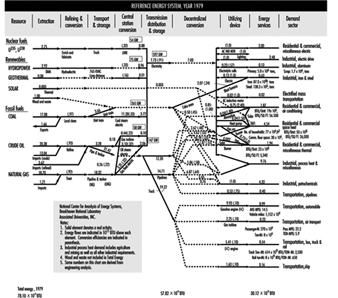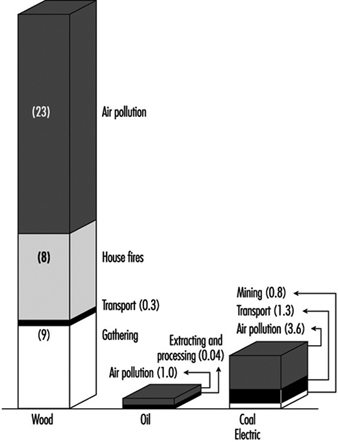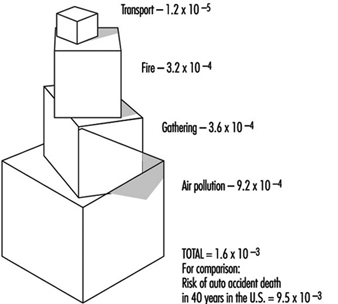The WHO Commission on Health and Environment (1992a) Panel on Energy considered four energy-related issues to be of the highest immediate and/or future concern for environmental health:
- exposure to noxious agents in the course of domestic utilization of biomass and coal
- exposure resulting from urban air pollution in numerous large cities of the world
- the possible health-related impacts of climate change
- serious accidents with environmental impacts on the health of the general public.
Quantitative assessment of the health risks from different energy systems requires system-wide evaluation of all steps in a fuel cycle, starting with extraction of raw resources, and concluding with the final consumption of energy. For valid intertechnology comparisons to be made, methods, data and end-use demands must be similar and specified. In quantifying the effects of end-use demands, differences in conversion efficiencies of energy- and fuel-specific devices to useful energy must be evaluated.
Comparative assessment is built around the idea of the Reference Energy System (RES), which depicts fuel cycles step-by-step, from extraction through processing to combustion and ultimate disposal of wastes. The RES provides a common, simple framework for defining flows of energy and related data used for risk assessment. An RES (figure 1) is a network representation of the main components of an energy system for a given year, specifying resource consumption, fuel transportation, conversion processes and end uses, thereby compactly incorporating the salient features of the energy system while providing a framework for assessment of major resource, environmental, health and economic effects that can result from new technologies or policies.
Figure 1. Reference energy system, year 1979
Based on their health risks, energy technologies can be classified into three groups:
- The fuels group is characterized by use of large amounts of fossil fuels or biomass—coal, oil, natural gas, wood and so on—the collection, processing and transport of which have high accident rates that dominate occupational risks and the burning of which produces large amounts of air pollution and solid waste that dominate public risks.
- The renewable group is characterized by use of diffuse renewable resources with low energy density—sun, wind, water—which are available in enormous quantities at no cost, but the capturing of which requires large areas and construction of expensive facilities capable of “concentrating” them into useful forms. Occupational risks are high and dominated by construction of the facilities. Public risks are low, mostly confined to low-probability accidents, such as dam failures, equipment failures and fires.
- The nuclear group includes nuclear fission technologies, distinguished by extremely high energy densities in the processed fuel, with corresponding low quantities of fuel and wastes to process, but with low concentrations in the earth’s crust, necessitating a large mining or collection effort. Occupational risks are, therefore, relatively high and dominated by mining and processing accidents. Public risks are small and dominated by routine operations of reactors. Special attention must be given to public fears of risks from exposure to radiation from nuclear technologies—fears which are relatively large per unit risk to health.
The significant health effects of technologies for generating electricity are shown in table 1, table 2 and table 3.
Table 1. Significant health effects of technologies for generating electricity - fuels group
|
Technology |
Occupational |
Public health effects |
|
Coal |
Black lung disease |
Air pollution health effects |
|
Oil |
Trauma from drilling accidents |
Air pollution health effects |
|
Oil shale |
Brown lung disease |
Cancer from exposure to |
|
Natural gas |
Trauma from drilling accidents |
Air pollution health effects |
|
Tar sands |
Trauma from mining accidents |
Air pollution health effects |
|
Biomass* |
Trauma from accidents during |
Air pollution health effects |
* As an energy source, usually considered as renewable.
Table 2. Significant health effects of technologies for generating electricity - renewable group
|
Technology |
Occupational |
Public health effects |
|
Geothermal |
Exposure to toxic gases - |
Disease from exposure to toxic |
|
Hydropower, |
Trauma from construction |
Trauma from dam failures |
|
Photovoltaics |
Exposure to toxic materials |
Exposure to toxic materials |
|
Wind |
Trauma from accidents during |
|
|
Solar thermal |
Trauma from accidents during |
Table 3. Significant health effects of technologies for generating electricity - nuclear group
|
Technology |
Occupational |
Public health effects |
|
Fission |
Cancer from exposure to radiation
|
Cancer from exposure to radiation
|
Studies of health effects of wood burning in the United States, like analyses of other energy sources, were based on the health effects of supplying a unit amount of energy, that is, that needed to heat one million dwelling years. This is 6 ×107 GJ heat, or 8.8 ×107 GJ wood input at 69% efficiency. Health effects were estimated in gathering, transport and combustion stages. Oil and coal alternatives were scaled from earlier work (see figure 2). The uncertainties in gathering are ± a factor of ~2, those in home fires ± a factor of ~3, and those in air pollution ± a factor greater than 10. If the hazards of nuclear electric were plotted on the same scale, the total risk would be approximately one-half that of mining for coal mining.
Figure 2. Health effects per unit amount of energy
A convenient way to help understand the risk is to scale it to a single person supplying one dwelling with wood over 40 years (figure 3). This results in a total risk of fatality of ~1.6 x 10–3 (i.e., ~0.2%). This can be compared with the risk of death in an automobile accident in the United States during the same time, ~9.3 x 10–3 (i.e., ~1%), which is five times greater. Wood burning presents risks which are of the same order as more conventional heating technologies. Both are well below the overall risk of other common activities, and many aspects of the risk are clearly amenable to preventive measures.
Figure 3. Risk, to a single person, of fatality due to supplying one dwelling with wood fuel for 40 years
The following comparisons for health risks can be made:
- Acute occupational risk. For the coal cycle, occupational risk is distinctly higher than that associated with oil and gas; it is about the same as that associated with renewable energy systems, when their construction is included in the assessment, and it is about 8-10 times higher than the corresponding risks for nuclear. Future technological advances in renewable solar and wind energy sources may result in a significant reduction in the acute occupational risk associated with these systems. Hydro-electricity generation entails comparatively high acute occupational risk.
- Late occupational risk. Late fatalities arise mainly in coal and uranium mining, and are roughly of the same size. Underground coal mining, however, appears to be more dangerous than underground uranium mining (calculation from the basis of a normalized unit of electricity generated). Use of surface-mined coal, on the other hand, leads in total to fewer late fatalities than does use of nuclear energy.
- Acute public risk. These risks, mostly due to transportation accidents, are highly dependent on distance travelled and mode of transport. The risk of nuclear is 10-100 times lower than those of all the other options, mainly because of the relatively low quantity of materials to be transported. The coal cycle has the highest acute public risk because of the large material transport using the same reasoning.
- Late public risk. There are great uncertainties associated with late public risks associated with all the energy sources. Late public risks for nuclear and natural gas are about equal and are, at least ten times lower than those associated with coal and oil. Future developments are expected to result in significant decreases in late public risks for renewables.
Clearly, health effects of different energy sources depend on the quantity and type of energy use. These vary greatly geographically. Fuelwood is the fourth largest contribution to world energy supply, after petroleum, coal and natural gas. Close to half the world population, especially those living in the rural and urban areas of developing countries, depend on it for cooking and heating (either wood or its derivative, charcoal, or, in the absence of either of these, on agricultural residues or dung). Fuelwood constitutes more than half the world’s consumption of wood, rising to 86% in developing countries and 91% in Africa.
In considering new and renewable sources of energy such as solar energy, wind power, and alcohol fuels, the idea of a “fuel cycle” must encompass industries such as solar photovoltaics, where virtually no risk attaches to the operation of the device but a substantial amount—often ignored—may be involved in its manufacture.
Attempts were made to deal with this difficulty by expanding the fuel cycle concept to include all stages in developing an energy system—including, for example, the concrete that goes into the plant that manufactures the glass for the solar collector. The issue of completeness has been addressed by noting that the backward analysis of manufacturing steps is equivalent to a set of simultaneous equations whose solution—if linear—is expressible as a matrix of values. Such an approach is familiar to economists as input-output analysis; and the appropriate numbers, showing how much each economic activity draws on the others, have already been derived—although for aggregate categories that may not exactly match the manufacturing steps one wishes to scrutinize for measuring health damage.
No single method of comparative risk analysis in the energy industry is fully satisfactory by itself. Each has advantages and limitations; each provides a different kind of information. Given the level of uncertainty of health risk analyses, results from all methods should be examined to provide as detailed a picture as possible, and fuller understanding of the magnitudes of associated uncertainties.


